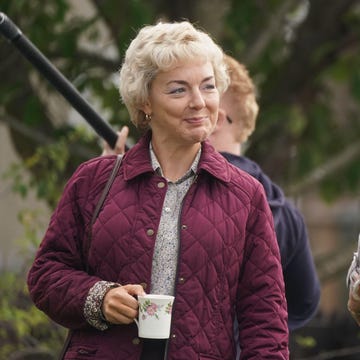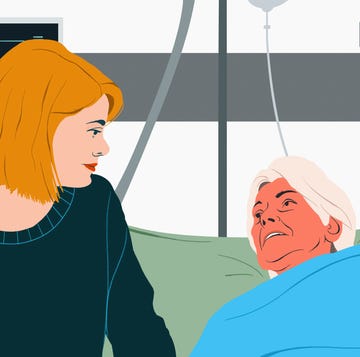This year, Good Housekeeping turns 100 in the UK and we have some very special content and a brilliant event planned to celebrate our centenary.
EARLY DAYS
It was on 22 February 1922 that Good Housekeeping first went on sale in the UK and our launch issue – which had a print run of 150,000 and cost one shilling - rapidly sold out. We went into profit by the time our third issue was printed in May and, by the end of our first year, could boast “treble the sales of any other women’s magazine at its price”.
LIFE IN THE 1920S
The magazine launched just after the First World War, at a time when life was dramatically changing for middle-class housewives. Many were no longer able to afford domestic staff, which had been the norm before the war, but still most women were determined to create the ‘Homes for Heroes’ that had been promised by the Prime Minister to returning troops.
It helps to picture the era by understanding that only 20% of women aged 20-64 were going out to work in this period (compared with around 80% today), and the average life expectancy of a woman was just 54 (compared with 81 now). And, while some progress was being made in female friendly legislation (1922 being the first time women were allowed to inherit property), it wasn’t until the end of the 20s that women were finally given equal voting rights to men.
OUR MISSION
So, into this world burst Good Housekeeping, with its promise to readers that: “There should be no drudgery in the house. There must be time to think, to read, to enjoy life, to be young with the growing generation, to have leisure time for one’s own – to hold one’s youth as long as possible, to have beauty around us – line and colour in dress, form and colour in our surroundings; to have good food without monotony.”
And we also declared that as a magazine we would do the following: “The burning questions of the day will be reflected in articles by women in the public eye, by women who are fearless and frank and outspoken.”
So, far from being a title that wanted women to be burdened by housework, Good Housekeeping was keen to help its readers run their homes well and efficiently, thereby freeing them up to enjoy life’s pleasures, and to take part in meaningful conversations on the issues that mattered. All of which has remained core to the brand’s DNA throughout the decades.
THE GOOD HOUSEKEEPING INSTITUTE
Critical to the success of the brand was the launch of The Good Housekeeping Institute, which opened its doors on London’s Wellington Street in 1924. The aim of the institute was – and always has been – to test products rigorously and highlight those that make readers’ lives easier; “every new invention that is practical and economical in use will be brought to notice after careful examination month by month”, as an early editorial put it.
Products were tested by the team of expert researchers just as a reader would use them at home, never taking manufacturers claims at face value. And only those products that proved reliable and good quality would receive GHI endorsement.
GADGETS THAT MAKE LIFE EASIER
The past 100 years has certainly seen a boon in labour-saving household appliances and so the team at the GHI has been kept busy.
The 30s saw the arrival of the first electric cookers with thermostatic controls, the Vent-Axia extractor fan and Goblin teasmade.
In the 1940s came the Kenwood Chef, while the 50s saw the arrival of microwaves in the UK and combined washer/spin dryers. In the 60s, thanks to mass production, huge democratisation of gadgetry occurred with prices of TVs, fridges and washing machines all falling and meaning the need for good advice on what to buy became ever greater.
And so it has continued, with 70s’ video recorders, 80s’ Sony Walkmans and Amstrad word processors among the life-changing technology that has arrived and been analysed at the GHI.
THOUGHT-PROVOKING FEATURES
Good Housekeeping has also remained a place for progressive editorial to lead our audience’s thinking on key matters of the time. There are countless examples – far too many to detail here - but among the articles that broke new ground at the time are:
- Lady Violet Bonham-Carter’s December 1922 article on ‘The Last Battle’, arguing for women needed to be given equal voting rights to men.
- In March 1930 Vera Britton wrote ‘Why I Think Mothers Can Have Careers’, arguing that women should be allowed to keep working when they got married and had children, going against the social norm of the time.
- In 1972 Good Housekeeping ran a feature calling for an end to the social stigma of homosexuality.
- Amazingly a ‘Good Earthkeeping Special’ ran in 1991, focused on sustainability and protecting the environment – years before such editorial was commonplace.
- And in August 2016 we featured Nadiya Hussain as our cover star, making Good Housekeeping one of the first lifestyle magazines in the UK to carry a woman with a hijab on its cover.
This tradition of highlighting trends and looking what’s coming down the tracks to make readers’ lives easier continues across all our platforms so you, our audience, can consume our content in whatever way you want.
NEW FORMATS
This year, we’re asking experts to make their predictions for the coming decades in a series of Future Gazing articles. And we’ve also launched the Futures prize in partnership with the Women’s Prize for Fiction, to highlight the next generation of female authors. You can vote for your favourite of the 10 authors our judging panel has shortlisted here.
Our incredible team of experts has also been charged with pulling together their 100 best pieces of advice in each of their specialist areas including beauty, cookery and homes amongst others. We want you to benefit from their experience and wisdom and promise these features will be a gold mine of brilliant tips and ideas. It’s not without reason that we carry the Tried, Tested, Trusted trademark – a century of passion, creativity and rigour has gone into everything we do.
THE FUTURE
So, while Good Housekeeping may be 100 years old this year, we don’t feel it (who does feel their age now anyway?) and those of us working on the brand today are taking up the baton and looking to what’s next. We are hugely proud of our heritage but also incredibly excited by our future. And we hope to see you in it!
You can now book tickets to the GH Live 2022 event in London, featuring expert talks and events with the Good Housekeeping team and a host of special guests.














![©ITV from monumental television frauds sr1pictured: jodie whittaker as sam suranne jones as bert this photograph is (c) itv plc/ monumental television and can only be reproduced for editorial purposes directly in connection with the programme or event mentioned above, or itv plc. this photograph must not be manipulated [excluding basic cropping] in a manner which alters the visual appearance of the person photographed deemed detrimental or inappropriate by itv plc picture desk. this photograph must not be syndicated to any other company, publication or website, or permanently archived, without the express written permission of itv picture desk. full terms and conditions are available on the website www.itv.com/presscentre/itvpictures/termsfor further information please contact:michael.taiwo1@itv.com](https://hips.hearstapps.com/hmg-prod/images/frauds-sr1-first-look-03-6891d81c2d536.jpg?crop=0.428xw:0.643xh;0.0641xw,0.116xh&resize=360:*)




